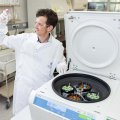The University of Queensland and CSIRO today announced Daryl Jackson Pty Ltd Architects as the preferred architects to develop what will be Australia's largest molecular-biological research facility when completed in 2002.
University Vice-Chancellor Professor John Hay said Daryl Jackson Architects had submitted an outstanding and imaginative design for the $100 million complex on the St Lucia campus. It would house the University's Institute for Molecular Bioscience (IMB), CSIRO Tropical Agriculture, and other facilities, as well as other public and private sector research groups.
"It will be a Brisbane landmark building reflecting its significance in the national science landscape," Professor Hay said.
Outstanding and visionary collaboration had made the project possible, he said.
The strategic community benefit would not have been achieved without the generous support of the Federal and State Governments who matched the University's $15 million seed funding with $15 million contributions each. Other major contributions were from CSIRO.
Prime Minister John Howard has previously announced that the Commonwealth Government's contribution would be from the Federation Fund, one of three major Queensland projects to receive assistance from this fund.
Queensland Premier Peter Beattie said: "The State Government has contributed $15 million because it is determined to do everything it can to ensure that Queensland is at the forefront of biotechnology development and the jobs that will come with this new-age industry."
The design for the six-storey building, featuring a sandstone colonnade and a pedestrian plaza linking the institute to adjacent University facilities, was unveiled today by Premier Beattie.
The design was selected by a panel chaired by Professor Hay and including Dr Malcolm McIntosh, Chief Executive Officer of CSIRO, and acclaimed architect Professor Daryl Le Grew, Vice-Chancellor of the University of Canterbury.
Professor Hay said the selection committee had received an exceptionally high standard of detailed submissions.
"The chosen design provides a handsome solution both aesthetically and functionally," he said.
"The panel sought a design which would reflect the cutting-edge nature of research to be conducted, as well as appropriately meeting the needs of the research tenants.
"The major scientific research centres to be accommodated collectively represent the most contemporary fields of modern biological, medical and agricultural science, from genetic discovery to the design of new pharmaceuticals."
Professor Hay said not only would the project provide massive potential economic benefit through the outcomes of scientific research and development, it also would provide significant immediate jobs and other benefits as a major construction project.
Cordell Building Information Services lists the UQ/CSIRO biological research complex and the $35 million seven-storey Mincom Central Brisbane CBD project (which started work in December) as two of Brisbane's largest current new building developments. The UQ/CSIRO project has a gross floor area of 35,000 square metres compared to the Mincom Central project with 27,000 square metres.
Construction on the St Lucia project is expected to start in March next year.
The UQ/CSIRO joint building project will house more than 700 world-class scientists involved in biological discovery in the areas of human disease, agriculture and the environment.
The Institute for Molecular Bioscience will include components of a number of University research centres the Centre for Molecular and Cellular Biology, Centre for Drug Design and Development, Centre for Microscopy and Microanalysis (Biological Division) and associated research groups.
In addition to CSIRO facilities, the Institute complex will also house the Australian Genome Research Facility and collaborating (non-University) research groups such as the Queensland Agricultural Biotechnology Centre within the Queensland Department of Primary Industries and the Wesley Research Institute.
The Institute for Molecular Bioscience would employ some 450 researchers, while CSIRO would have an additional 250 scientists, making a centre complex of 700 staff.
Pix are available for downloading from the University of Queensland ftp site: http://photos.cc.uq.edu.au/ in the folder entitled IMB.
For further information, contact the Vice-Chancellor, Professor John Hay, telephone 07 3365 1300.



